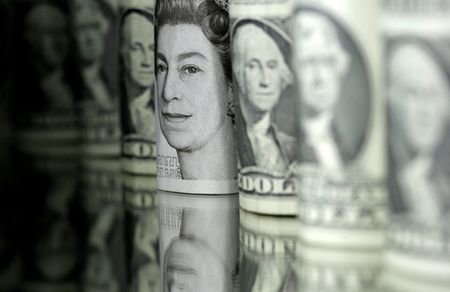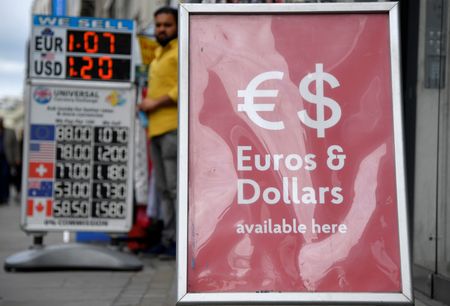By John McCrank
NEW YORK (Reuters) – Sterling rallied to a six-week high on Tuesday on improved risk sentiment as Rishi Sunak became Britain’s prime minister, while the dollar fell to a three-week low as weakening U.S. economic data cooled expectations on the pace of future U.S. rate hikes.
The potential for foreign exchange volatility is elevated this week, with central banks in the euro zone and Canada expected to hike rates by 75 basis points, and the Bank of Japan set to maintain ultra-low interest rates to support its fragile economy.
Rishi Sunak became Britain’s third prime minister in two months on Tuesday, tasked with tackling a mounting economic crisis and a warring political party.
Sterling surged to its strongest level since Sept. 15, and was last up 1.66% at $1.147, but currency strategists expect the pound’s climb to be short-lived.
“Beyond a brief honeymoon phase rally, I think the daunting road ahead for the UK economy is likely to cap sterling gains,” said Joe Manimbo, senior market analyst at Convera.
The U.S. dollar was broadly weaker amid signs that Federal Reserve rate hikes are slowing the world’s biggest economy. The greenback slid into negative territory after data showed that U.S. home prices sank in August as surging mortgage rates sapped demand.
“U.S. economic data is deteriorating and that is helping push down Treasury yields,” said Edward Moya, senior market analyst at Oanda. “If the data keeps on getting uglier, the December FOMC meeting debate might not be between a half point increase and 75 basis point hike, but with a quarter point rise and 50 basis-point boost.”
The Fed is expected to raise rates by 75 basis points for a fourth-straight time at its Nov. 1-2 meeting.
The dollar index, which measures the greenback against six major peers, was down 0.822% at 110.94 at 3:10 p.m. EDT (1910 GMT).
The euro strengthened to a 20-day high ahead of Thursday’s ECB meeting, where a three-quarter point hike is expected by the central bank as it seeks to rein in red-hot inflation.
The common currency was last up 0.87% at 0.99595.
“Warm weather is fueling (relative) optimism about the energy crisis, even if Germany’s IFO data is deep into recessionary territory,” said Kit Juckes, chief FX strategist at Societe General.
The Ifo Institute for Economic Research said Germany is heading into recession, forecasting that Europe’s biggest economy will contract by 0.6% in the fourth quarter.
YEN AND YUAN
The yen firmed against the dollar after suspected Bank of Japan (BOJ) intervention on Friday and Monday.
A retreat this week in long-term Treasury yields also helped support the Japanese currency. However, the policy background for yen weakness is likely to be put into stark relief in coming days, with the BOJ expected to stick to monetary stimulus on Friday.
At 147.96 yen, the dollar was down from a 32-year high against the Japanese currency of 151.94 on Friday, which appeared to trigger successive bouts of BOJ intervention.
Japan’s Ministry of Finance declined to comment on whether it had ordered interventions in recent days, though it did confirm action in September, which was the first yen-buying foray by Japanese authorities since 1998.
China’s currency, meanwhile, extended the weakness seen since Chinese leader Xi Jinping’s choice of leadership team at the twice-a-decade Communist Party Congress raised fears that growth will be sacrificed for ideology-driven policies.
The onshore yuan slid to its lowest in nearly 15 years on Tuesday after the central bank set the lowest mid-point since 2008. The offshore yuan dipped to a record low of 7.375 against the dollar.
(Reporting by John McCrank in New York and Joice Alves in London; Editing by David Goodman, Bernadette Baum and Nick Zieminski)


